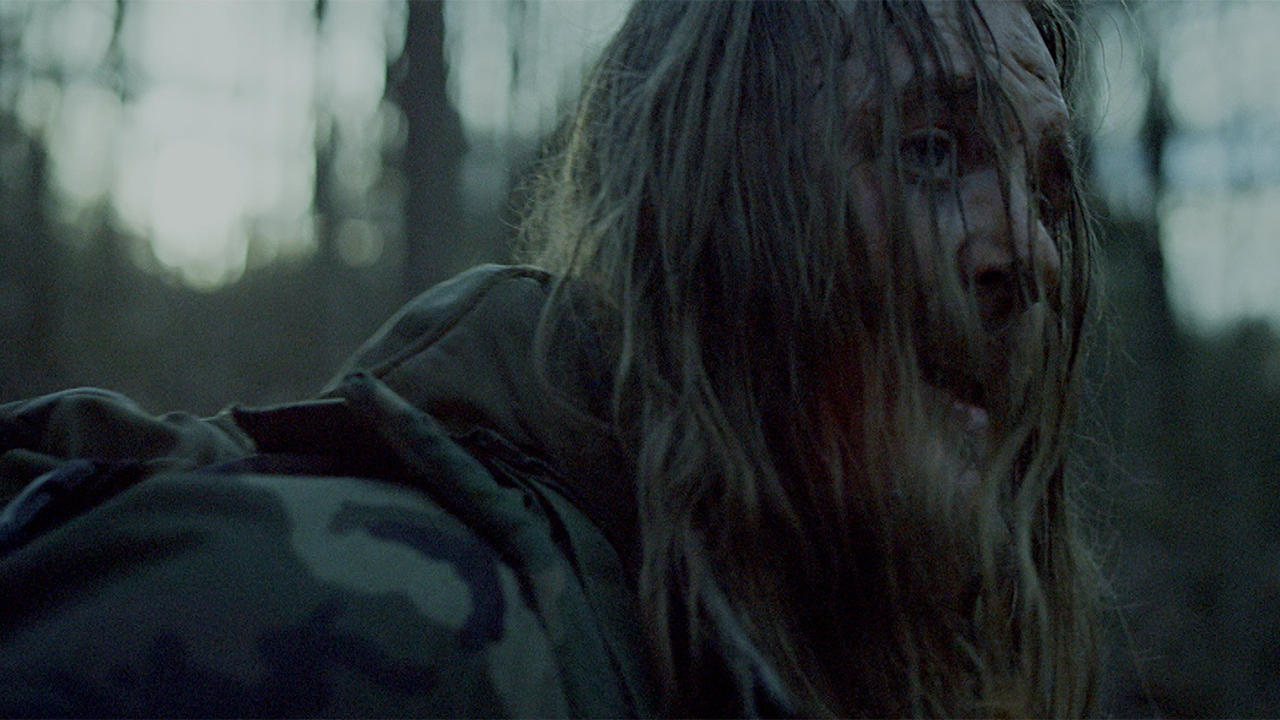In Writer/Director Marshall Burnette’s Devil’s Damned To Try, Riley Anglen plays a man credited simply as “The Hunter”, a grizzled sawmill worker going through a rough patch. He’s been late to work the past three days, his wife has left him (via voicemail) — and to top it all off, in his introductory scene, The Hunter is burying a rifle in the middle of a rainstorm. Premiering exclusively online today with Short of the Week, Devil’s Damned To Try stands tall as an accomplished work with feature sensibilities, a deliberately-paced Southern morality tale with big rewards awaiting the patient viewer.
“No one can lie, no one can hide anything, when he looks directly into someone’s eyes.” – Paulo Coelho
[Spoilers throughout]
Devil’s Damned To Try works much like a puzzle: jumping between parallel timelines, Burnette dares the audience to keep up as his narrative twists and turns until it finally recoils — like the ouroboros — back in on itself. In the present (or is it the past?) we watch The Hunter struggle at work, keep tabs on a house from his old blue Suburban, and become entangled with a pretty blonde at a roadside motel bar. As the present cross-cuts with the past, The Hunter (dressed in full camo) tosses his cell phone, grabs the rifle we saw him bury earlier, and treks off into the woods on a solo hunting trip. What do these two story lines have to do with one another, you ask, and how will they eventually merge? Therein lies Devil’s’ closely-guarded secrets, and Burnette is in no hurry to reveal them. The slow-burn may not work for everyone, but in this reviewer’s humble opinion, the studied pace and dialogue restraint (The Hunter nary says ten words) proves the Writer/Director’s talent, riffing on Shane Caruth just as much as Jeff Nichols or David Gordon Green. Aided by some stellar cinematography — shot mostly in long-lens close-ups by DP Dustin Lane — and a moody score of angry cellos and acoustic strings, Devil’s offers Burnette the chance to throw his name into the ring as a Southern filmmaker to watch.
In a lesser actor’s hands, The Hunter’s trials and tribulations would feel trite and melodramatic, but lucky for Burnette (and the film), Riley Anglen is more than up for the challenge. After noting Anglen’s talent during a music video shoot, Burnette knew he wanted to cast the actor in a more significant role. “[The music video] was a comedy,” Burnette said, “and I wanted to created something intense and dramatic that could showcase Riley’s talent for understanding human emotion. Riley and I both grew up in Northeast Tennessee, so hunting was something we were really familiar with, and we hadn’t seen many short films on the subject.” But the real inspiration for this Southern offering comes from a land far away from its Tennessee setting. “I was reading some articles and found this story of two men in Norway who covered up an accidental hunting death and got away with it for almost five years, until the guilt finally drove them to turning themselves in. That was a really interesting idea for me and Riley, so I started writing based [off that premise].”
According to the director, Anglen’s dedication knew no bounds. “We were in the woods prepping to shoot Riley breaking down with his back against a tree,” Burnette said. “He began to cry before the lights and camera were even ready, so we rolled on the scene. Our DP, Dustin Lane, shoved a bounce card in Riley’s lap, using only his headlamp as light. [The entire crew] got really quiet as Riley released emotion for over ten minutes, then we cut. Everyone was tearing up and giving hugs afterwards. It was such a short scene in the film, but meant a lot to everyone involved. There is a lot of Riley’s personal experience and emotion in this film, and that will always be special to me.”
Burnette and a group of local crew members shot for eight days in March of 2013, lensing on a set of “old Lomo Sphericals” in Chattanooga, Nashville, and Murfeesboro, TN. Using only mostly natural light proved difficult, especially for scenes that required lots of coverage. “We needed it to look as consistent as possible, [so] we had to work really quickly and had some very lucky weather that supplied us the perfect look for [certain scenes].” Another element that proved challenging (and one that’s definitely worth a re-watch, just to admire the technical skill on display) was the scene in which The Hunter smashes his head against a mirror. “The one-take scene in the hunter’s bedroom took us eight hours and sixteen mirrors to pull off successfully. Riley’s head never actually touched the mirror; it was a detailed choreographed scene that we invented the day-of on set.” To add insult to injury, the cast and crew also battled with a fussy picture car. “The old blue suburban caught fire on us three times,” Burnette said. “We had a hood mount on the front with the camera on top and noticed smoke coming out from under the hood…We just pulled the air filter out, got our shots, then drove the car home really slow.”
Burnette is currently in development on his first feature film that’s based on “a tragic true story from a small farming town in Illinois”. Between research trips for the the feature, he’s also planning another short film — based on a short story by Breese DJ Pancake — which he hopes to shoot this winter in West Virginia.

 Ben Watts
Ben Watts